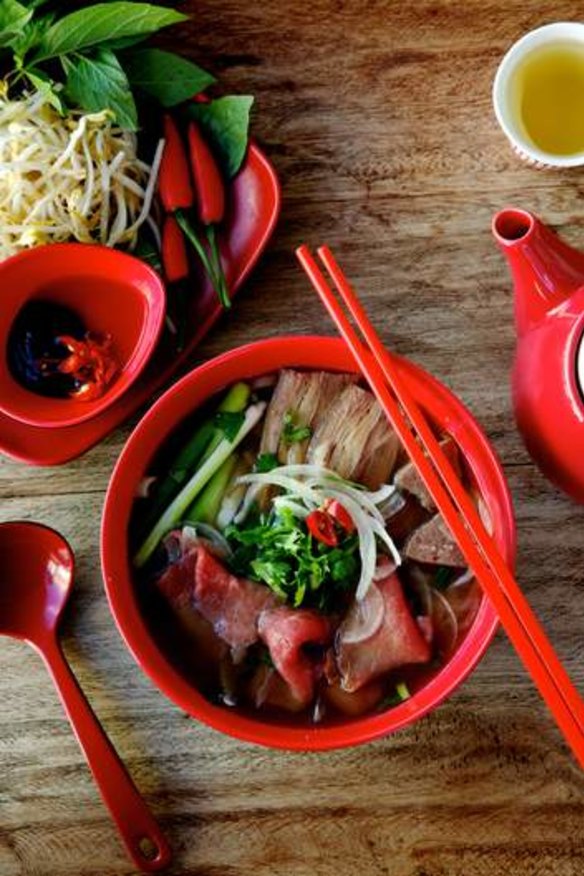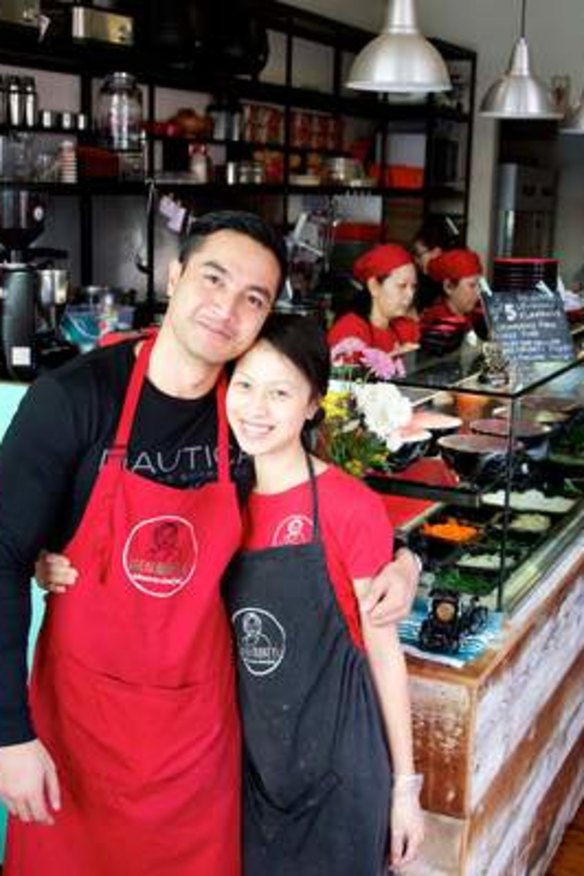Sydney's best pho
Food fads come and go, but these full-flavoured Vietnamese noodle soups are never out of fashion.

Sydney loves a food trend. We adore tucking into the must-eat dish, snack or ingredient of the moment. But there are some food addictions that span years, even decades, that never find themselves at the bottom of the thumbs-down list. They are part of the dining pulse of this town. One of these addictions is pho.
Pho is up there with the great noodle soups of the world, says Merivale chef Dan Hong. "The spices within the clean and clear broth have almost healing properties, and it makes you feel great when eating it."
Hong says pho can be slurped any time. One of his earliest memories was of his mother, Angie Hong, making "a large batch, and we would eat it for breakfast or dinner for at least the next two days until it was gone". He adds: "It's also the perfect hangover cure."

The complex broth is derived from boiling beef bones for hours. The meat topping is almost always beef - pho tai (uncooked thin slices of beef), pho nam (cooked beef), pho bo vien (beef balls).
There are other varieties. Pho ga (chicken) is tolerated, but purists will grimace at pho do bien (seafood) and pho chay (vegetarian).
With so many ingredients and regional differences, each chef has their own, closely guarded recipe. Sweet, star anise-perfumed, fish sauce-rich, ginger-spiced - each bowl is as distinct as the hands that create it.
Pho has a somewhat murky history, though most agree it originated in the north of Vietnam in the 1880s during the French colonisation. The Chinese living in the north contributed the rice noodle component of the soup, while the French introduced beef, a previously extravagant meat, to this street food bowl.
Chef Luke Nguyen had his first pho at about four years of age; his parents used it to teach him how to use chopsticks. Researching for his latest TV series, Luke Nguyen's France, he concluded that pho actually has it origins in France. According to Nguyen, pho bears similarities to the French classic pot-au-feu in name and cooking method. "The essential cooking technique of both dishes is the same - to extract all the natural sweet flavours of the beef bones, meat and vegetables to get a very clean, aromatic, tasty broth."
In 1954, when Vietnam was split into communist north and democratic south, those who migrated south to avoid communism helped spread the love of pho. Pho bac (northern pho) reflects the austere, considered character of that region, while pho nam (southern pho) embodies the brashness of the easy-going south.
"Northern pho tends towards subtle, light, mild, clean flavours; the south tends towards a sweeter yet sharper flavour from exotic fresh herbs, aromatic spices with Indian, Cambodian and Thai influences," Nguyen says.
With the end of the Vietnam War in 1975, pho spread, thanks to Vietnamese refugees, to the West, where the pho flavour evolved further. Many claim pho in Australia is tastier thanks to better-quality beef that gives the broth a bigger, richer punch.
Whether north, south or Aussie, watch out ramen, laksa and handmade noodles - pho is coming for you.
Sydney's best pho
Pho Tau Bay
12/117 John Street, Cabramatta, 9726 4583
Critics and connoisseurs consistently name this tiny noodle house as one of Sydney's best. Cabramatta's first pho restaurant began in 1980 as a Sunday pop-up in Thi Nhu Pham's garage. With an infant son, it was the only way to make money to support her husband and the rest of her children back in Vietnam. Within two years she saved enough capital to open Pho Tau Bay at the current location. Pham's recipe is a well-guarded secret; no one knows how she gets that amazing depth of flavour or how she balances sweet, saltiness and Asian spices so perfectly.
Pho An
29 Greenfield Parade, Bankstown, 9796 7826
Dan Hong's favourite pho, this institution attracts punters from all over Sydney. Enter this vast, double-fronted restaurant and you'll be greeted by the aroma of basil leaves and the sound of happy, slurping diners.
Pho An is renowned for its seductive, aromatic broth with star anise, clove and Chinese cardamom that many have unsuccessfully tried to emulate.
PHD
308 Illawarra Road, Marrickville, 9559 5078
Previously Pho Bac Hai Duong, but shortened to PHD after a bold makeover. Hien Le is front of house, while wife Lanh Nguyen cooks up a storm in the kitchen. The owners come from Hue, so while they serve pho nam (southern-style), it has a central Vietnam twist. This is one of the sweetest pho in Sydney, with generous use of beef and chicken bones, onions, ginger and fried garlic. It's finished with cracked pepper - another marked difference.
Bo 7 Mon Thanh Tam
Level 3, Market City, 8-9 Hay Street, Haymarket, 8252 7815
Don't be fooled by its location; one of the best pho stops in Sydney's CBD is in a food court. For two decades, owner Phuoc Hoang has run restaurants all over Sydney, including Darlinghurst, Bankstown and Canley Heights. These days he's in a food court to escape the punishing restaurant hours. It's a punchy umami-rich broth that makes the nearby competitors taste watered-down. At $9 a bowl, the food court price is a sweet bonus.
Cafe Buon Cibo
33 Herbert Street, St Leonards (no phone)
A sweeping generalisation, but the further away from the Vietnamese hubs of Cabramatta, Bankstown and Marrickville, the harder it is to find decent pho. This cafe-cum-pho eatery on the ground floor of an office block in St Leonards is a redolent exception. The owners, Allan Thai and his mother, cook the broth overnight in their home in Cabramatta and drive the 70-litre pho pot to the north shore each weekday.
Each bowl is served with pride, piping-hot, including all the condiments you'd expect from a Cabramatta restaurant.
Pho Huong Xua
Shop 4, 219 Canley Vale Road, Canley Heights, 8764 4117
One of a few places in Sydney for subtle, elegant pho bac (northern-style). While the broth is clean, the beef is lightly stir-fried with fish sauce and garlic.
They're also renowned for Australia's biggest pho bowl, which weighs in at 1.5 kilograms, with equal parts of noodles, beef and soup. At $17 it's also the best-value bowl in town (but eat it all in 11 minutes and it's free!).
Great Aunty Three
115 Enmore Road, Enmore, 9519 2886
Just off King Street, look for the red Vespa, bright plastic stools and long queues. This is hipster pho with a solid pedigree - the recipe is passed on from owner Michael Le's maternal grandmother. It's a fragrant bowl, thanks to basil and star anise. While you're there, go the whole hog and order a gourmet banh mi, fresh roll and a glass of Vietnamese drip coffee.
Hai Au
48 Canley Vale Road, Canley Vale, 9724 9156
This place is one of the most popular restaurants for the local Vietnamese community, renowned for in-your-face, authentic home-style Viet.
And if chicken is your thing, then pho ga at Hai Au is the best in town. It is a complex broth, umami-rich and highly spiced with basil, chopped coriander, spring onion and fried garlic, though it is the sliced Spanish onions that give the bowl a distinctive sweetness.
Duy Linh
Shop 10, 117 John Street (Enter via Hill Street), Cabramatta, 9727 9800
Vegans rejoice - here's is a pho for you. It's a sweet broth with a surprisingly firm punch. Mercifully, there's no mock-beef, though two types of mushrooms add earthy heartiness. Basil, coriander and ginger help to evoke the pho feel.
Pho Pasteur
295 Chapel Road, Bankstown, 9790 2900; 709 George Street, Sydney, 9212 5622; 137 Church Street, Parramatta, 9635 0782; Westpoint Shopping Centre, Patrick Street, Blacktown, 9676 1333.
Pasteur was the first to take pho outside the Vietnamese hubs, spreading the love to Haymarket, Parramatta and Blacktown. It's an accessible broth, hedging its bet - neither too sweet nor too salty.
How to eat it
A steaming bowl of pho at your table is just the start - what you add to it will really make the experience. After all, no two bowls are alike.
Dunk: Pho tai (raw beef) arrives with thinly sliced red beef on top of your bowl. Grab your chopsticks and immediately submerge into the piping-hot broth to cook. This applies to pho nam (cooked beef) or other meats such as pho ga (chicken), to bring your meat to the same temperature as your pho bowl.
Sides: That plate of side mints can really help to lift your bowl.
Fresh is best: You may be offered lightly blanched bean sprouts. This practice originates from Vietnam. In Australia, pick fresh sprouts for a crispier, more lively texture. You get a lot of sprouts on the plate, but one handful is usually enough - too much will prematurely cool the broth.
Rip it: Asian basil is another standard side (flee out of there if it's not). You should get a few stems. Only use the leaves; discard the wiry stems. Tear the basil leaves in two before dropping into your bowl to release the flavour into the broth. This one tip can make a world of difference.
Zest: Lemon should be squeezed to taste - usually no more than one slice per bowl.
Condiments: That cluster of inscrutable condiments taking up valuable room on your table should be loved, not loathed:
F is good: Sometimes sauces are transferred to generic glass containers, but there's a simple guide. Usually, there are two containers with dark, runny sauces; the one marked with a handwritten "F" is fish sauce (add half a tablespoon for extra saltiness), the one marked with "S" is soy (to be used for other dishes - avoid if you're having pho).
Squeeze it: The black paste in the squeeze container is hoisin. Some add it to their bowl instead of fish sauce, but most squeeze onto one side of a small side dish to dip your meat in. The red squeeze container is chilli sauce, to be added to the other half of the dipping dish for a yin-yang look.
Spice it up: Finally, if your side dish doesn't come with chilli, look for a small aluminium sugar container - it usually contains freshly sliced chilli. Three slices should warm you up, six if you're brave.
Free tea: Unlike some Chinatown restaurants, bottomless tea is free. The waiter usually brings enough tea cups for your table. Help yourself to hot oolong from the large thermos on your table.
Restaurant reviews, news and the hottest openings served to your inbox.
Sign up